Which heating system of a private house is better: water, air or electric?

Gone are the days when residents of private houses gladly moved to cramped, but "comfortable" high-rise buildings. After all, only here the wonderful benefits of civilization were available in the form of the coveted centralized heating. Time has passed and autonomous heating of a private house with their own hands has become available to almost everyone, a similar system can be equipped without any difficulties. The main thing is to choose the right type of structure, correctly design and install it. In order to prevent mistakes in such important matters, it is worth getting to know the types of heating systems that can be equipped in any private house. There are several options for heating systems. Their main difference is in the form of the coolant used to heat the room. Let us consider in more detail each of the structures.
Content
Option # 1 - water heating
The system is designed as a closed loop, through which the heated coolant circulates. In this capacity, water or an antifreeze liquid based on ethylene glycol, the so-called antifreeze, can be used. The second option is convenient when the system can be defrosted. As a heat source, a boiler is used that heats the coolant to the desired temperature values. The heated liquid through the pipes enters the batteries, where it gives off heat. Then it returns to the boiler. Here it warms up again, and the cycle begins anew.
The circulation circuit includes a piping system that allows the coolant to move through heating devices, and auxiliary elements: an expansion tank, valves, an air collector, and others. Elements from various materials can be used to equip the pipeline:
- steel;
- copper;
- polypropylene;
- cross-linked polyethylene;
- metal-plastic.
Boilers designed for water heating systems differ in the type of fuel used.
Gas fired boilers
Considering that gas is the cheapest type of fuel, in the overwhelming majority of cases such equipment is chosen. In the process of gas combustion, the maximum amount of heat is generated, and the toxicity of emissions into the atmosphere is minimal. Design Advantages:
- Profitability. High efficiency and cheap fuel.
- Long term of operation. Steel models will last 30 years, cast iron - 50 years.
- There is no need to create fuel reserves.
- Monitoring during operation of the system is not required.
Deficiencies of equipment are considered to be the need to bring a gas main to the house; when connected, preparation and approval of project documentation in the relevant services is required. In addition, there is a possibility that seasonal pressure surges in the gas line will lead to system shutdown and equipment breakdown.
Oil boilers
For the operation of the equipment, various liquid fuels are used, most often diesel. The design of the device is such that it functions automatically during the entire heating period. The system is easy to maintain and maintain. Its advantages include:
- Full autonomy. Automation requires electricity, but it can be obtained by installing an additional power source.
- High efficiency, which reaches 94%.
- The minimum level of toxic emissions.
Disadvantages oil boilers Considered the high cost of both fuel and equipment. Also, there is a need to use a fine filter, otherwise the boiler will quickly fail. You may also have to equip a room with an extractor hood to install a heater and allocate a special place to store fuel supplies.
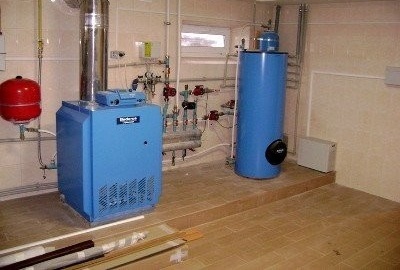
Oil boilers are very efficient and highly efficient, but high fuel prices make them not economical enough.
Solid fuel systems
Boilers operate on various solid fuels. It includes firewood, pellets, coal, briquettes, peat, etc. A more modern variation is the so-called long-burning equipment, in which the fuel combustion cycle is significantly increased. "Pros" of solid fuel equipment:
- Relatively low cost.
- Long term of operation.
- Functioning without electricity consumption, which allows you to equip a fully autonomous heating system of a private house
The “minuses" include laborious care, the need for constant monitoring of equipment. It is also noted that the efficiency here is lower than that of other systems. Well, for everything else, there is a need for a special room for storing fuel supplies.
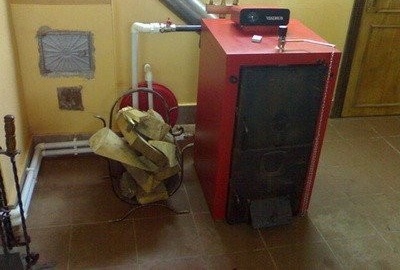
Solid fuel boilers can operate on various types of fuel: pellets, wood, coal, peat, etc. Moreover, their efficiency is not very high
Electricity Equipment
Such heaters operate by consuming electricity. When choosing such a device, it is necessary to take into account the features of local networks. In the case of frequent outages, it makes sense to take care of a backup generator or install an additional boiler that runs on other fuels. Advantages of equipment:
- Compactness. The installation of a separate boiler room and the installation of the chimney is not required.
- Easy to operate.
- Ecological cleanliness.
- Low cost of equipment.
Of the shortcomings, it is worth noting low efficiency - the power consumption is quite large. Also, for appliances with a capacity of more than 6 kW, a three-phase network of 380 V is required, and in the presence of power surges, the automation of the boilers quickly fails.
Combined boilers
These are devices designed to operate on various types of fuel. There are several types of equipment. The most popular devices are two burners that operate on liquid fuel and gas, with a chamber designed for solid fuel and with mounted burners operating on solid, liquid fuel and gas. As well as equipment equipped with two combustion chambers and a heating element, which makes it possible to use four types of fuel. Virtue combined boilers considered universality, which allows them to function in case of interruptions with the main fuel.
The “minuses" of the devices include the high cost of equipment, heavy weight and solid dimensions, as well as the volatility of devices, the automation of which is powered by electricity.
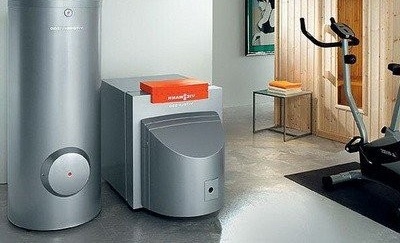
Combined boilers are especially relevant for areas where there are interruptions in the supply of a certain type of fuel. there are models that can run on four different types of fuel
Features of designing a water system
A water heating system can be designed in many different ways. There are two and single-circuit design. The latter includes one circuit and can only be used for heating a building. While the first is equipped with two circuits at once, one of which is used for heating, and the second is used to organize hot water supply. In practice, two single-circuit systems are also very often installed. Using the first, the building is heated, and the second warms up the water. The advantage of this method is that in warm time only one boiler is used, designed to heat water.
Based on the method of movement of the coolant emit:
- Single pipe system. With this arrangement of the structure, the liquid sequentially moves from one battery to the next. Accordingly, its temperature in each subsequent device will be lower. If there are a lot of them, then the latter may not warm up enough. The main disadvantages of such a system: the inability to adjust the room temperature and the need to turn off the entire pipeline for repair work.
- Double pipe system. Two radiators are connected to each radiator. One brings the heated coolant, the other - removes the cooled one. Pipes are connected to the batteries in parallel, which allows you to disconnect devices from the system if necessary. Heat loss in the last radiator is much less than that of a single-tube design.
- Collector system. It involves the installation of a collector, from which the pipes go to each radiator separately. One is the preheated coolant, the second - the cooled is returned. The system makes it possible to adjust the temperature in the room and turn off areas for repair and maintenance. The main disadvantage is too much pipe consumption, as well as the need to install a manifold cabinet.
Coolant circulation inside the pipeline can be carried out natural or forced way. In the first case, the movement of the fluid occurs due to the difference in the density values of the heated and chilled water. The diameter of the vertical risers is projected large enough to generate an incentive force. For the organization of forced circulation are used special pumps different powers that set the fluid in motion. The diameter of the pipes in this case will be less.
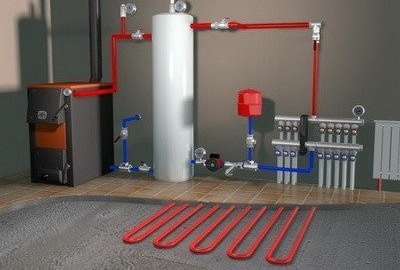
The use of collector wiring allows the most rational arrangement of the heating system. In this case, you can adjust the temperature of each radiator and disconnect it from the system if necessary
Water heating for a private house used in most cases. Such popularity is explained by the indisputable advantages of this method:
- The ability to ensure uniform heating of radiators, respectively, and a comfortable temperature.
- Many options for arrangement, which allows you to choose the best way in each case.
- High level of heat capacity of the coolant, which exceeds the heat capacity of air by 4,000 times.
- Use of pipelines of a smaller diameter than for air or steam systems.
- The ability to adjust the degree of heating of heating devices.
- Relatively low cost, low consumption of materials.
The disadvantages of the system are traditionally complex installation, possibility of airing, the risk of rupture of the pipeline during freezing and rapid corrosion of pipes in the absence of water. In addition, the installation of water heating is possible only during the construction process or overhaul of the building.
Option # 2 - air heating systems
An alternative to water heating is considered aerial. The principle of its work is to move the heated air through the building. It happens as follows. Air is pumped into the heat exchanger of the heat generator, where it is heated. The optimum warming temperature will be considered 50 ° -60 °. Hot air is sent through air ducts to the heated room. After cooling, it returns to the heat generator through special openings or air ducts. Then the cycle repeats.
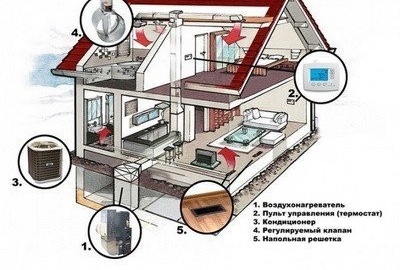
Air heating is economical and low energy. Lack of an intermediate heat carrier allows to save additionally on pipelines and radiators
Air heating in the system can be carried out in several ways:
- Using a gas burner. Moreover, the source of fuel can be both a cylinder and a gas pipeline.
- By means of a heat pump.
- Using a diesel burner or a waste oil appliance.
- Hot water taken from a central heating system.
Ducts can be made of various materials. Long elements are not recommended for installation, since in this case there is heat loss. To prevent them, several auxiliary heat generators are introduced into the system. The optimal duct length is considered to be 30 m, and its branches - 15 m. A rational solution is to supplement the air heating with an air conditioning unit. Thus, all year in the building you can maintain a comfortable temperature by cooling it in the heat and heating in the cold. In addition, the system can be supplemented with a sterilizer or humidifier.
Room ventilation can be carried out in different ways:
- Natural. It is assumed that hot air rises and moves randomly through the duct. The main disadvantage of this method is that cold air accidentally falling through doors or windows into the room disrupts circulation. Hot air rushes up and warms the ceiling, while cold air accumulates below, creating significant discomfort.
- Forced. It is carried out using powerful fans that accelerate the air flow. Such a system works great in all conditions, even when there is an influx of cold air. Its disadvantage is the noise generated by working fans.
Air heating has several advantages:
- Profitability and low power consumption. Radiators and pipelines are absent, there is also no intermediate coolant, which allows saving on its heating.
- High efficiency.
- The possibility of combining heating with modern ventilation and air conditioning systems.
- High speed of heating the room, it only takes about half an hour.
- Easy installation and maintenance.
- Long operation.
The system, however, has its drawbacks. So, the temperature difference is at the level of the floor and the ceiling, which can be 10 ° in rooms of standard height and 20 ° in high. Plus, there is a need to use special filters on the air intakes, otherwise a sufficiently large amount of dust will be present in the room. Some also complain of constant fan noise.
The video shows the principle of operation of an air heating system:
Option # 3 - Electric Heating
Circuit diagram electric heating systems simple enough and does not imply the presence of an intermediate coolant. It includes the required amount. convectors. Devices heat the room using the phenomenon of convection. Devices directly convert electrical energy into heat, which is given to air. The latter circulates around the room and warms it up. On average, convectors give about 80% of the heat, which makes such devices quite efficient. The main disadvantage of the systems is the uneven heating of the room. Cold air accumulates at the floor, and hot air rises. Therefore, they are often used together with the "warm floor».
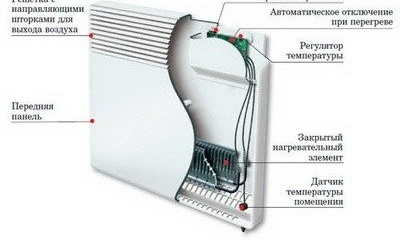
Convectors directly convert electrical energy into heat. The figure shows the device of such a device
The advantages of electric heating systems include:
- Easy installation and use.
- Compact sizes of heating devices that do not require special care.
- The ability to effectively control the level of heating of the air in the room.
- Silent operation of the system.
- High hygiene and environmental friendliness.
Thanks to these advantages, electrical systems have become very popular in Europe. In our country, they are less known, although they are considered very promising. This is due to such disadvantages of systems as:
- Instability in the supply of electricity. When it is turned off, housing remains without heating for an indefinite period, which is unacceptable in the harsh Russian winter.
- The high cost of electricity, which in the future will only grow.
To electrical systems can also include cable, rod and film "warm floors", as well as infrared filmsused for ceiling laying. They can be considered as full-fledged main heating only for buildings built in a relatively mild climate. For all others, such systems can only be used as a supplement.
Conclusions on the topic - what to choose?
There are many options for arranging heating in a private house. The developer, faced with the problem of choice, must understand that for each house you can choose several solutions that can seriously differ from each other. The final decision should be made after a real assessment of their financial capabilities, a careful study of local conditions and consideration of all the pros and cons of a particular system. Only such an approach to business ensures that heating will work without problems and the house will always be warm.
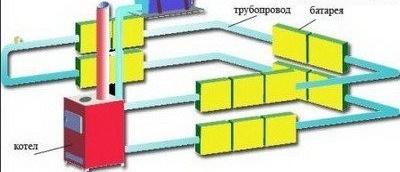
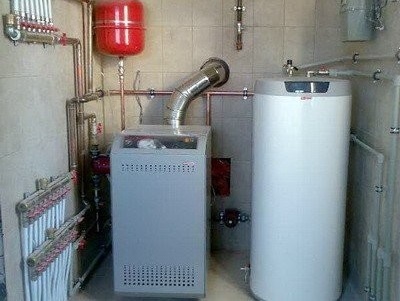


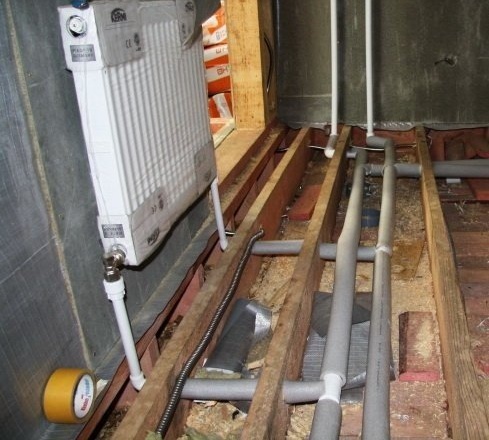
1 comment